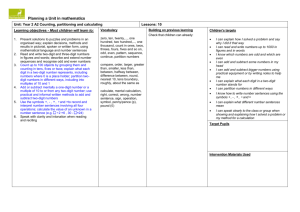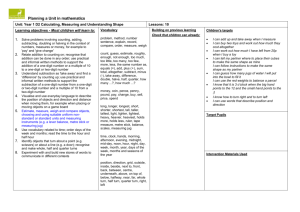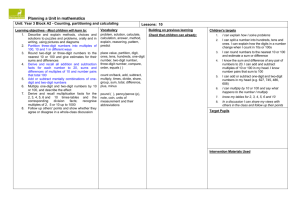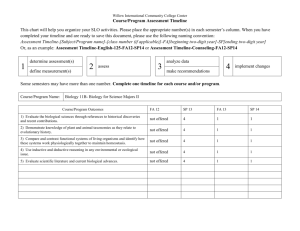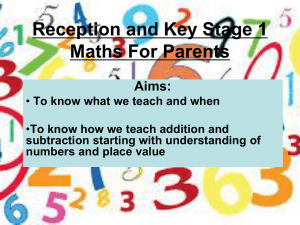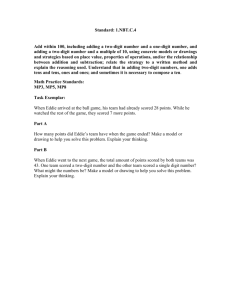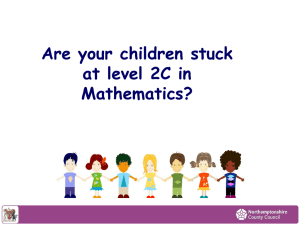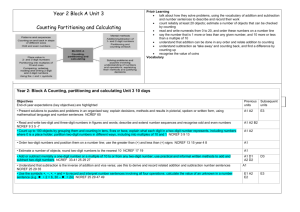Y2 Block A Unit 1
advertisement
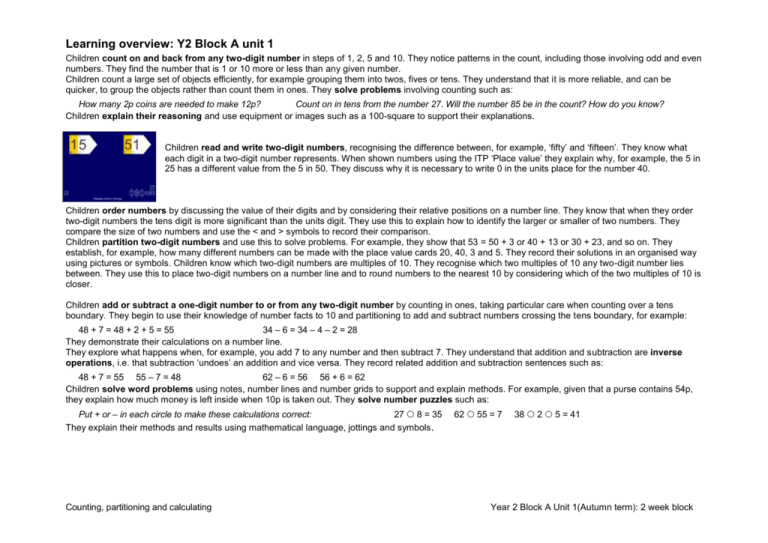
Learning overview: Y2 Block A unit 1 Children count on and back from any two-digit number in steps of 1, 2, 5 and 10. They notice patterns in the count, including those involving odd and even numbers. They find the number that is 1 or 10 more or less than any given number. Children count a large set of objects efficiently, for example grouping them into twos, fives or tens. They understand that it is more reliable, and can be quicker, to group the objects rather than count them in ones. They solve problems involving counting such as: How many 2p coins are needed to make 12p? Count on in tens from the number 27. Will the number 85 be in the count? How do you know? Children explain their reasoning and use equipment or images such as a 100-square to support their explanations. Children read and write two-digit numbers, recognising the difference between, for example, ‘fifty’ and ‘fifteen’. They know what each digit in a two-digit number represents. When shown numbers using the ITP ‘Place value’ they explain why, for example, the 5 in 25 has a different value from the 5 in 50. They discuss why it is necessary to write 0 in the units place for the number 40. Children order numbers by discussing the value of their digits and by considering their relative positions on a number line. They know that when they order two-digit numbers the tens digit is more significant than the units digit. They use this to explain how to identify the larger or smaller of two numbers. They compare the size of two numbers and use the < and > symbols to record their comparison. Children partition two-digit numbers and use this to solve problems. For example, they show that 53 = 50 + 3 or 40 + 13 or 30 + 23, and so on. They establish, for example, how many different numbers can be made with the place value cards 20, 40, 3 and 5. They record their solutions in an organised way using pictures or symbols. Children know which two-digit numbers are multiples of 10. They recognise which two multiples of 10 any two-digit number lies between. They use this to place two-digit numbers on a number line and to round numbers to the nearest 10 by considering which of the two multiples of 10 is closer. Children add or subtract a one-digit number to or from any two-digit number by counting in ones, taking particular care when counting over a tens boundary. They begin to use their knowledge of number facts to 10 and partitioning to add and subtract numbers crossing the tens boundary, for example: 48 + 7 = 48 + 2 + 5 = 55 34 – 6 = 34 – 4 – 2 = 28 They demonstrate their calculations on a number line. They explore what happens when, for example, you add 7 to any number and then subtract 7. They understand that addition and subtraction are inverse operations, i.e. that subtraction ‘undoes’ an addition and vice versa. They record related addition and subtraction sentences such as: 48 + 7 = 55 55 – 7 = 48 62 – 6 = 56 56 + 6 = 62 Children solve word problems using notes, number lines and number grids to support and explain methods. For example, given that a purse contains 54p, they explain how much money is left inside when 10p is taken out. They solve number puzzles such as: Put + or – in each circle to make these calculations correct: 27 8 = 35 They explain their methods and results using mathematical language, jottings and symbols . Counting, partitioning and calculating 62 55 = 7 38 2 5 = 41 Year 2 Block A Unit 1(Autumn term): 2 week block Counting, partitioning and calculating Year 2 Block A Unit 1(Autumn term): 2 week block Learning objectives 1999 links • Read and write two-digit and three-digit numbers in figures and words; describe and extend number sequences and recognise odd and even numbers Year 2 Count up to 100 objects by grouping them and counting in tens, fives or twos; explain what each digit in a two-digit number represents, including numbers where 0 is a place holder; partition two-digit numbers in different ways, including into multiples of 10 and 1 • Order two-digit numbers and position them on a number line; use the greater than (>) and less than (<) signs • Estimate a number of objects; round two-digit numbers to the nearest 10 • Add or subtract mentally a one-digit number or a multiple of 10 to or from any two-digit number; use practical and informal written methods to add and subtract two-digit numbers • Understand that subtraction is the inverse of addition and vice versa; use this to derive and record related addition and subtraction number sentences 3, 5, 7, 9 Year 2 3, 9, 13 Year 2 13,15 & Year 4 8 Year 2 17, 19 Year 2 33–41 25,29,27 Year 2 25,29, 35 Focus of using and applying Present solutions to puzzles and problems in an organised way; explain decisions, methods and results in pictorial, spoken or written form, using mathematical language and number sentences Vocabulary Building on previous learning Children's targets zero, ten, twenty, …, one hundred, two hundred, …, one thousand, count in ones, twos, threes, fours, fives and so on, odd, even, pattern, sequence, continue, partition numbers Check that children can already: I can read and write two-digit numbers I know which numbers are odd and which are even I can count objects by putting them into groups I can partition numbers I can write numbers in order and position them on a number line I can use the greater than and less than symbols to show that one number is larger or smaller than another I can round numbers to the nearest 10 I can add and subtract some numbers in my head I know that addition and subtraction ‘undo’ each other I can write three other related number sentences for 6 + 3 = 9 compare, order, larger, greater than, smaller, less than, between, halfway between, difference between, round, nearest 10, tens boundary, roughly, about the same as calculate, mental calculation, right, correct, wrong, number sentence, sign, operation, symbol, penny/pence (p), pound (£) • talk about how they solve problems, using the vocabulary of addition and subtraction and number sentences to describe and record their work • count reliably at least 20 objects; estimate a number of objects that can be checked by counting • read and write numerals from 0 to 20, and order these numbers on a number line • say the number that is 1 more or less than any given number, and 10 more or less than a multiple of 10 • understand that addition can be done in any order and relate addition to counting • understand subtraction as ‘take away’ and counting back, and find a difference by counting up Year 2 65 • UAM children’s targets I can explain to others how I solved a problem Speaking and listening children’s targets I can speak clearly to the class or group when I show and explain how I solved a problem or my method for a calculation recognise the value of coins Focus on speaking and listening: Speak with clarity and intonation when reading and reciting texts Counting, partitioning and calculating Year 2 Block A Unit 1(Autumn term): 2 week block Block E unit 3 Block D unit 3 Block C unit 3 Block B unit 3 Block A unit 3 Block E unit 2 Block D unit 2 Block C unit 2 Block B unit 2 Block A unit 2 Block E unit 1 Block D unit 1 Block C unit 1 Block B unit 1 Read and write two-digit and three-digit numbers in figures and words; describe and extend number sequences and recognise odd and even numbers Block A unit 1 Year 2 Block A Present solutions to puzzles and problems in an organised way; explain decisions, methods and results in pictorial, spoken or written form, using mathematical language and number sentences Count up to 100 objects by grouping them and counting in tens, fives or twos; explain what each digit in a two-digit number represents, including numbers where 0 is a place holder; partition two-digit numbers in different ways, including into multiples of 10 and 1 Order two-digit numbers and position them on a number line; use the greater than (>) and less than (<) signs Estimate a number of objects; round two-digit numbers to the nearest 10 Add or subtract mentally a one-digit number or a multiple of 10 to or from any two-digit number; use practical and informal written methods to add and subtract two-digit numbers Understand that subtraction is the inverse of addition and vice versa; use this to derive and record related addition and subtraction number sentences Use the symbols +, –, ×, ÷ and = to record and interpret number sentences involving all four operations; calculate the value of an unknown in a number sentence (e.g. ÷ 2 = 6, 30 – = 24) Counting, partitioning and calculating Year 2 Block A Unit 1(Autumn term): 2 week block Week Mental/Oral (rehearse, recall, 1 refine, reason, revisit, read) Objectives Activity Main Activity Objectives Key vocabulary Plenary Direct teaching Key questions Activities - (considering lower, middle and higher achievers) Indicate organisation and support. Resources (incl ICT) Review, reflect. Key questions Mon Tues Wed Thur Fri Assessment and future action Counting, partitioning and calculating Homework Year 2 Block A Unit 1(Autumn term): 2 week block Week Mental/Oral (rehearse, recall, 2 refine, reason, revisit, read) Objectives Activity Main Activity Objectives Key vocabulary Plenary Direct teaching Key questions Activities - (considering lower, middle and higher achievers) Indicate organisation and support. Resources (incl ICT) Review, reflect. Key questions Mon Tues Wed Thur Fri Assessment and future action Counting, partitioning and calculating Homework Year 2 Block A Unit 1(Autumn term): 2 week block
